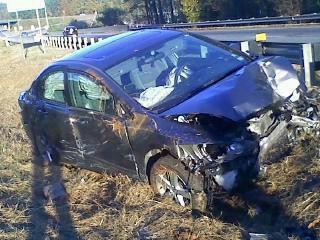
Teen Drowsy Driving
December 8, 2014
Drowsy driving among teens is an issue that doesn’t get much notice when compared with all the other issues teen drivers face on the road but it’s a critical problem in the US. The following story is a typical example of the problem.
A 16 year old driver with less than 6 months solo experience behind-the-wheel set out, after school and cross country practice, with his 14 year old brother as a passenger to pick up their mother.
The driver reported that his younger brother had fallen asleep on the passenger side and, suffering from highway hypnosis, and no one to talk to, he started feeling drowsy himself. He planned to stop at the next gas station and get some coffee to help him stay awake but he didn’t make it! He fell asleep long enough for the car to drift off the road.
The car hit a guardrail at approximately 55 mph and went airborne. When the car finally stopped, it was facing in the opposite direction of traffic (see the photo above). Fortunately, both brothers escaped with minor injuries; lots of bruises and, for the younger brother, a concussion.
This crash wasn’t reported in the newspapers and the driver, instead of being ticketed for careless driving, received only a warning. The reason this crash came to light was that the two boys involved are my only grandchildren and we came very close to losing them on that day.
Drowsy driving is a major problem on America’s roads.
- According to the National Sleep Foundation, 60% of Americans have driven while feeling sleepy and 37% admit to actually having fallen asleep at the wheel in the past year.
- A study by the Eastern Virginia Medical School showed that teens with early school start times don’t get enough sleep and the crash rate for teens is higher in districts where schools start earlier than 8:30 AM
The problem with drowsy driving is that, once a driver starts to feel drowsy, it’s impossible to tell when that driver will actually fall asleep. Many drivers will try to push on through with disastrous results. Even though the next gas station was less than 2 miles away, my grandson was unable to stay awake long enough to make it.
Instead of waiting until he reached the next gas station, the best thing to do would have been to pull the car as far as possible off the road. Then he could have gotten out and let the cool air refresh him or even put the seat back to take a short nap.
Even if you make it to a gas station where you can get a cup of coffee, it will take approximately 20 to 30 minutes for the caffeine to reach your system and start waking you up. Experts advise that, after drinking the coffee, the driver should take a short “caffeine nap.” Taking a short nap while waiting for the caffeine to kick in will ensure that you are doubly refreshed and ready to resume driving. It’s better to be late than to never arrive at all!
The most important thing that saved their lives was the fact that both were wearing their seat belts. There were two separate impacts in this crash; the first when the car hit the guardrail and the second when the car crashed again after going airborne. Had they not been wearing their seat belts, on initial impact, both boys would have continued traveling forward at 55 mph. Each weighed approximately 140 pounds; that means they would have each struck the wheel, dashboard, or windshield with a crash force of approximately 14,000 pounds. They would have been thrown around like rag dolls before crashing the second time.
If no other lesson is learned from this crash, always remember that:
